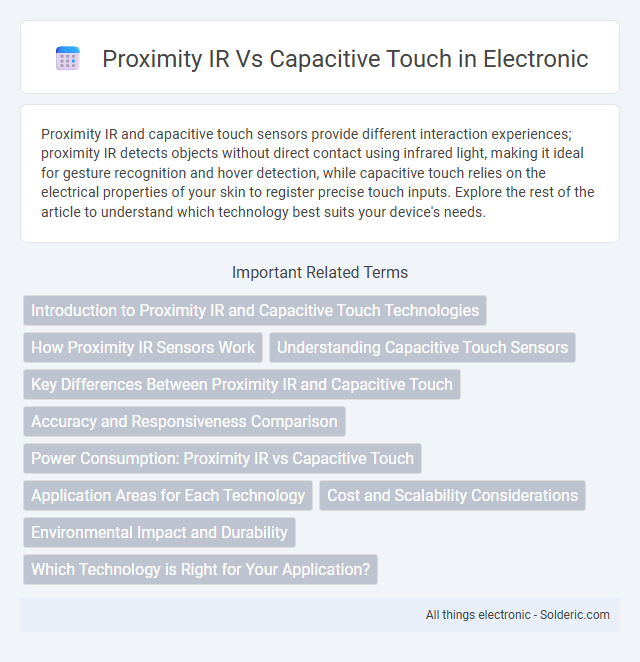Proximity IR and capacitive touch sensors provide different interaction experiences; proximity IR detects objects without direct contact using infrared light, making it ideal for gesture recognition and hover detection, while capacitive touch relies on the electrical properties of your skin to register precise touch inputs. Explore the rest of the article to understand which technology best suits your device's needs.
Comparison Table
| Feature | Proximity IR Sensor | Capacitive Touch Sensor |
|---|---|---|
| Detection Method | Infrared light reflection | Changes in electrical capacitance |
| Touch Requirement | No physical contact required | Requires direct touch or close contact |
| Range | Typically 1-10 cm | Surface contact only |
| Environmental Sensitivity | Affected by ambient light and reflectivity | Less affected by external light |
| Power Consumption | Moderate power use | Generally low power |
| Applications | Object detection, gesture control | Touchscreens, buttons, user interface inputs |
| Cost | Low to moderate | Moderate to high |
| Sensitivity | Good for proximity, not precise touch | High precision touch detection |
Introduction to Proximity IR and Capacitive Touch Technologies
Proximity IR technology uses infrared light to detect the presence or absence of an object without physical contact, enabling touchless interaction often found in smartphones and automatic faucets. Capacitive touch technology relies on detecting changes in electrical charge caused by a conductive object, such as a human finger, to register precise touch inputs on devices like tablets and touchscreens. Both technologies enhance user experience with distinct sensing methods--Proximity IR excels in gesture recognition and non-contact detection, while capacitive touch offers high accuracy for direct touch control.
How Proximity IR Sensors Work
Proximity IR sensors operate by emitting infrared light and detecting reflections from nearby objects, enabling touchless interaction by measuring the intensity and timing of the reflected signal. Unlike capacitive touch sensors that rely on changes in electrical charge caused by direct contact, IR sensors identify presence and distance without physical touch. This makes proximity IR ideal for applications requiring gesture recognition or hands-free control in various environmental conditions.
Understanding Capacitive Touch Sensors
Capacitive touch sensors detect touch through the change in the electrostatic field caused by the conductive properties of your skin, offering high precision and multi-touch capabilities. In contrast, proximity IR sensors identify nearby objects without direct contact by emitting infrared light and measuring its reflection, which is less sensitive to touch details. Understanding capacitive touch sensors helps you appreciate their responsiveness and accuracy in devices like smartphones and tablets.
Key Differences Between Proximity IR and Capacitive Touch
Proximity IR sensors detect objects based on infrared light reflection without requiring physical contact, making them ideal for hands-free interactions and presence detection. Capacitive touch sensors rely on changes in electrical charge caused by the conductive properties of a finger, enabling precise touch input and multi-touch capabilities. The key differences lie in their interaction modes--proximity IR senses near objects through emitted IR light, while capacitive touch necessitates direct skin contact for input recognition.
Accuracy and Responsiveness Comparison
Proximity IR sensors detect objects without requiring direct contact, offering fast responsiveness but sometimes lower accuracy due to ambient light interference. Capacitive touch technology provides precise input by sensing electrical conductivity changes when Your finger touches the surface, ensuring high accuracy and consistent responsiveness. For applications demanding exact touch detection and swift response times, capacitive touch generally outperforms proximity IR in delivering reliable user interaction.
Power Consumption: Proximity IR vs Capacitive Touch
Proximity IR sensors typically consume less power than capacitive touch sensors because they detect objects without requiring continuous activation from direct contact. Capacitive touch technology demands more energy to maintain an electrostatic field and process touch events, which can increase overall power consumption. Optimizing your device's battery life may benefit from using proximity IR in applications where low power usage is critical.
Application Areas for Each Technology
Proximity IR sensors excel in applications requiring contactless detection such as automated doors, gesture recognition devices, and industrial automation systems, where non-contact interaction enhances safety and hygiene. Capacitive touch technology dominates consumer electronics including smartphones, tablets, and touchscreen kiosks, offering precise, responsive input by detecting the electrical properties of the human finger. Both technologies serve distinct fields: proximity IR for distance measurement and presence detection, and capacitive touch for direct, tactile user interface control.
Cost and Scalability Considerations
Proximity IR sensors typically offer lower costs and simpler integration, making them more scalable for large-scale deployments in cost-sensitive projects. Capacitive touch technology demands higher initial investment due to complex hardware and sensitivity calibration but provides superior accuracy and multi-touch capabilities, which may justify the expense in premium applications. Evaluating your project's budget and scalability requirements will help determine whether the efficient, lower-cost proximity IR or the more advanced capacitive touch system aligns better with your goals.
Environmental Impact and Durability
Proximity IR sensors consume less power and have fewer electronic components, resulting in a lower environmental impact compared to capacitive touch sensors that often rely on complex multi-layered materials and frequent replacements. Capacitive touch technology faces durability challenges in harsh environments due to susceptibility to moisture and dirt, whereas proximity IR sensors maintain performance by detecting objects without direct contact, enhancing longevity. Choosing proximity IR over capacitive touch reduces electronic waste and improves device lifespan, supporting sustainable product design.
Which Technology is Right for Your Application?
Proximity IR sensors detect objects without physical contact by measuring infrared light reflection, making them ideal for applications requiring non-touch activation or gesture controls, especially in environments prone to dirt or moisture. Capacitive touch sensors rely on detecting changes in electrostatic fields through direct skin contact, offering precise, multi-touch functionality suitable for interactive displays and user interfaces demanding high accuracy and responsiveness. Choosing between proximity IR and capacitive touch depends on factors such as the desired level of user interaction, environmental conditions, and the necessity for touchless operation versus direct touch input.
proximity IR vs capacitive touch Infographic

 solderic.com
solderic.com